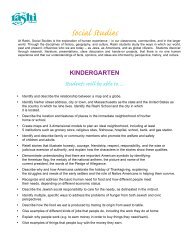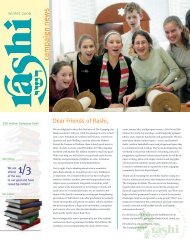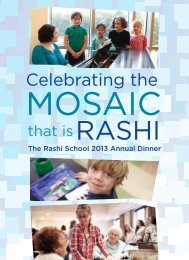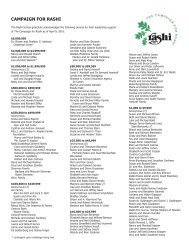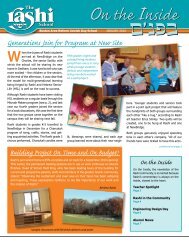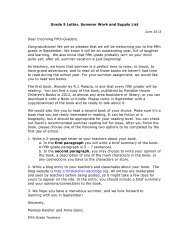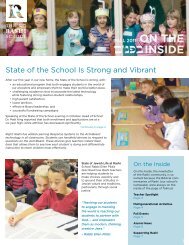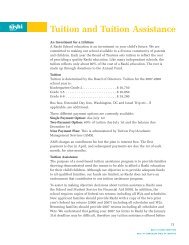GRADE 6 Language Arts ⢠Reads and discusses ... - The Rashi School
GRADE 6 Language Arts ⢠Reads and discusses ... - The Rashi School
GRADE 6 Language Arts ⢠Reads and discusses ... - The Rashi School
Create successful ePaper yourself
Turn your PDF publications into a flip-book with our unique Google optimized e-Paper software.
<strong>GRADE</strong> 6<br />
<strong>Language</strong> <strong>Arts</strong><br />
• <strong>Reads</strong> <strong>and</strong> <strong>discusses</strong> novels, short stories, myths, <strong>and</strong> informational texts in depth.<br />
• Identifies <strong>and</strong> underst<strong>and</strong>s the basic elements of fiction (plot, character, setting, dialogue,<br />
foreshadowing, conflict, motif).<br />
• Identifies <strong>and</strong> <strong>discusses</strong> how an author manipulates aspects of plot structure including the<br />
development, climax <strong>and</strong> resolution.<br />
• Underst<strong>and</strong>s texts by questioning, predicting, visualizing, inferring, summarizing, synthesizing<br />
new <strong>and</strong> prior information.<br />
• Recognizes issues <strong>and</strong> ideas that are central to a text.<br />
• Identifies <strong>and</strong> communicates the motifs that are central to a text.<br />
• Accesses textual evidence <strong>and</strong> uses it to support a position during literature discussions.<br />
• Writes in the following forms: personal narrative, description, short story, <strong>and</strong> expository<br />
paragraph.<br />
• Writes a brief interpretation or explanation of a literary or informational text using evidence from<br />
the text as support.<br />
• Writes a persuasive piece that uses facts, examples, <strong>and</strong>/or supporting information to persuade<br />
readers.<br />
• Writes a properly structured formal letter.<br />
• Constructs a dangling thesis <strong>and</strong> a dangling conclusion.<br />
• Masters subject-verb agreement, pronoun-antecedent agreement, <strong>and</strong> correction of misplaced<br />
modifiers.<br />
• Spells correctly <strong>and</strong> gives precise meanings for 200 grade-appropriate words.<br />
• Follows the steps of the writing process from planning to self-assessment.<br />
• <strong>Reads</strong> his/her work aloud during various points during the writing process.<br />
• Memorizes <strong>and</strong> performs 15 lines of a character from a Shakespearean play.<br />
• Applies Maimonides' Ladder of Tzedakah to the central themes in a text.<br />
• Applies a rabbinic commentary on "Justice, justice you shall pursue" to the central themes in a<br />
text.<br />
Mathematics<br />
• Compares <strong>and</strong> orders groups of large numbers, decimals, fractions, percents, <strong>and</strong> mixed<br />
numbers.<br />
• Converts efficiently between fractions, decimals, <strong>and</strong> percent representations.<br />
• Underst<strong>and</strong>s the meaning <strong>and</strong> effects of arithmetic operations with fractions, decimals, <strong>and</strong><br />
percents.<br />
• Defines negative numbers <strong>and</strong> performs four arithmetic operations.<br />
• Applies order of operations to simplify expressions with division, subtraction, multiplication,<br />
division, <strong>and</strong> grouping symbols.<br />
• Solves problems involving scale factors, using ratio <strong>and</strong> proportion, staying in the same<br />
dimension.<br />
• Develops an initial conceptual underst<strong>and</strong>ing of different uses of variables.<br />
1
• Recognizes, names, <strong>and</strong> categorizes three dimensional shapes (prisms, pyramids, cylinders,<br />
cones) <strong>and</strong> use nets of these shapes.<br />
• Calculates perimeter, area, volume <strong>and</strong> surface area, as well as memorizes the key formulas<br />
related to these calculations.<br />
• Draws geometric objects with specified properties, such as side lengths or angle measurements.<br />
• Uses two-dimensional representations of three-dimensional objects to visualize <strong>and</strong> solves<br />
problems such as those involving surface area <strong>and</strong> volume.<br />
• Converts between units within the metric system.<br />
• Uses common benchmarks to select appropriate methods for estimating measurements.<br />
• Selects, creates, <strong>and</strong> uses appropriate graphical representations of data including histograms,<br />
box plots, line plots, <strong>and</strong> scatter plots.<br />
Jewish Studies<br />
• Explains the process of commentary on the Torah as a literary tradition.<br />
• Employs additional access skills when reading blocks of text independently.<br />
• Discusses holiness in its various contexts in the Tanakh.<br />
• Explains how the holidays connect to the text.<br />
• Articulates rabbinic influences on modern holidays <strong>and</strong> their observances<br />
• Traces events of the narrative focusing on details <strong>and</strong> complex themes.<br />
• Recognizes special literary characteristics of the Books of Vayikra <strong>and</strong> Bamidbar.<br />
• Draws text connections between the Books of Vayikra <strong>and</strong> Bamidbar to his/her life.<br />
Science<br />
• Follows lab directions <strong>and</strong> uses equipment correctly.<br />
• Explains the roles <strong>and</strong> relationships among producers, consumers <strong>and</strong> decomposers in the<br />
process of energy transfer in a food web.<br />
• Explains <strong>and</strong> gives examples of ways in which organisms interact <strong>and</strong> have different functions in<br />
an ecosystem.<br />
• Determines how animals are broken down by other living organisms <strong>and</strong> how this process<br />
contributes to the system as a whole.<br />
• Underst<strong>and</strong>s how human behavior impacts the environment.<br />
• Relates the survival of a species in its ability to adapt.<br />
• Gives examples of ways in which genetic variation <strong>and</strong> environmental factors are causes of<br />
evolution <strong>and</strong> the diversity of organisms.<br />
• Recognizes that all organisms are composed of cells <strong>and</strong> that in one-celled organisms the cell<br />
must carry out all of the basic functions of life.<br />
• Compares <strong>and</strong> contrasts plant <strong>and</strong> animal cells, including major organelles.<br />
• Classifies organisms into the currently recognized kingdoms according to the characteristics that<br />
they share.<br />
• Describes the hierarchal organization of multi-cellular organisms from cells to tissues to organs<br />
to systems to organisms.<br />
• Identifies the general functions of the major systems of the human body <strong>and</strong> describes ways<br />
that these systems interact with each other.<br />
Social Studies<br />
• Explains the political <strong>and</strong> economic factors that contributed to the American Revolution.<br />
• Explains the influence <strong>and</strong> ideas of the Declaration of Independence.<br />
• Explains the reasons for the adoption of the Articles of Confederation, including why its drafters<br />
created a weak central government.<br />
• Describes the causes, course, <strong>and</strong> consequences of America’s westward expansion <strong>and</strong> its<br />
growing diplomatic assertiveness.<br />
2
• Describes the rapid growth of slavery in the South after 1800, <strong>and</strong> analyzes slave life <strong>and</strong> the<br />
struggle for freedom on plantations <strong>and</strong> farms across the South.<br />
• Compares <strong>and</strong> contrasts the Jewish notion of slavery with the treatment of slaves in Africa.<br />
• Describes how the different cultures <strong>and</strong> economies of the North <strong>and</strong> South contributed to the<br />
growing divide in politics between these two regions in the beginning of the 19th century.<br />
• Summarizes the critical developments leading to the Civil War including the Missouri<br />
Compromise, the Dred Scott Supreme Court case, the Lincoln-Douglas debates, <strong>and</strong> the election<br />
of Abraham Lincoln.<br />
• Explains the policies <strong>and</strong> consequences of Reconstruction.<br />
• Describes how the Industrial Revolution led to the development of a factory economy, <strong>and</strong> how<br />
the factory economy transformed the Northern states.<br />
Hebrew<br />
• Engages in conversations to provide <strong>and</strong> obtain information, express likes/dislikes, feelings, <strong>and</strong><br />
emotions.<br />
• Tells about personal experiences during transition, feelings <strong>and</strong> emotions (easy, hard, I<br />
like/dislike…).<br />
• Uses the future tense of Binyan Paal in real life contexts.<br />
• <strong>Reads</strong>/listens to stories/testimonials of children about their transitions, adjusting <strong>and</strong> starting<br />
new beginnings.<br />
• Underst<strong>and</strong>s the main ideas <strong>and</strong> many details of authentic texts.<br />
• Uses verbal <strong>and</strong> nonverbal cues (contextual <strong>and</strong> morphological) to interpret spoken <strong>and</strong> written<br />
texts in Hebrew.<br />
• Recounts biographies of famous Jews/Israelis; tells salient facts about the life of a famous<br />
person using a sequence of sentences.<br />
• <strong>Reads</strong> a biography (semi-authentic) of a person in Jewish/Israeli history, <strong>and</strong> underst<strong>and</strong>s most<br />
of the main points <strong>and</strong> most of the details.<br />
• Composes interview questions, interviews someone <strong>and</strong> writes a summary.<br />
• Retells <strong>and</strong> summarizes stories (paraphrases) he/she reads <strong>and</strong> underst<strong>and</strong>s the main ideas <strong>and</strong><br />
details of the stories.<br />
• <strong>Reads</strong> <strong>and</strong> comprehends different genres, describes the characters/places in the book,<br />
summarizes the story, creates a dialogue between characters <strong>and</strong> infers the meaning of<br />
unfamiliar words using contextual clues.<br />
Fitness & Health<br />
• Designs <strong>and</strong> performs a fitness (or dance) sequence that combines balance <strong>and</strong> weight transfer<br />
with changes in direction <strong>and</strong> speed.<br />
• Identifies proper warm-up, cool down <strong>and</strong> stretching techniques <strong>and</strong> the reasons for using<br />
them.<br />
• Sets realistic physical activity goals <strong>and</strong> strives to attain them through participation in activities<br />
of his/her choosing.<br />
• Measures <strong>and</strong> maintains a heart rate within target heart rate zone for a minimum of 20 minutes<br />
of a physical activity of their choice.<br />
• Demonstrates ability to work independently.<br />
• Seeks physical activity as a positive outlet for competition <strong>and</strong> social interaction.<br />
• Demonstrates underst<strong>and</strong>ing of how to clean <strong>and</strong> take care of materials <strong>and</strong> tools.<br />
• Demonstrates underst<strong>and</strong>ing of how to use elements of design to create visual effects.<br />
Art<br />
3
• Demonstrates interest <strong>and</strong> engagement in the artistic process through reflective response to<br />
verbal prompts about his/her work.<br />
• Demonstrates underst<strong>and</strong>ing of various artistic styles <strong>and</strong> influences through questions <strong>and</strong><br />
prompts.<br />
• Demonstrates underst<strong>and</strong>ing of self-reflective practice through drafting <strong>and</strong> selecting a final<br />
product.<br />
• Demonstrates underst<strong>and</strong>ing of Jewish cultural <strong>and</strong> religious tradition by creating works of<br />
Judaica.<br />
• Demonstrates underst<strong>and</strong>ing of Islamic principles of design.<br />
• Demonstrates independence <strong>and</strong> creative problem solving skills.<br />
• Remains engaged in the project throughout class time.<br />
• Participates in class discussions of artists <strong>and</strong> artistic styles.<br />
<strong>GRADE</strong> 7<br />
<strong>Language</strong> <strong>Arts</strong><br />
• Underst<strong>and</strong>s <strong>and</strong> analyzes elements <strong>and</strong> structures of poetic forms: the sonnet, free verse, the<br />
lyric poem, <strong>and</strong> the ballad.<br />
• Identifies <strong>and</strong> underst<strong>and</strong>s character development, subtext, soliloquies, <strong>and</strong> monologues in<br />
plays.<br />
• Compares <strong>and</strong> contrasts passages from two different pieces of literature.<br />
• Analyzes an author's use of literary techniques, such as symbolism, dramatic irony, the use of<br />
sub-plots, foreshadowing <strong>and</strong> reversal.<br />
• Recognizes common figures of speech: metaphor, simile, personification, hyperbole, extended<br />
metaphor, onomatopoeia, alliteration.<br />
• Explores the theme of how humans treat each other in person-to-person interactions, local<br />
community mores <strong>and</strong> structures, larger community rights <strong>and</strong> laws.<br />
• Writes in the following genres: poetry (sonnet, ballad, lyric, free verse); drama (dialogue);<br />
expository writing (persuasive essay, biography, author study).<br />
• Revises work using a variety of editing strategies: condenses text, elaborates text, adjusts<br />
sentence structure, improves word choice to enhance content.<br />
• Constructs a well-developed introductory paragraph that includes background information, a<br />
concession-assertion thesis, <strong>and</strong> a preview of information.<br />
• Constructs a well-developed conclusion paragraph that includes a restated thesis, a summary of<br />
information, <strong>and</strong> a clear closing statement.<br />
• Masters correct punctuation (comma, ellipsis, semi-colon, colon, dash, hyphen).<br />
• Identifies <strong>and</strong> models the four basic types of sentences: simple, complex, compound <strong>and</strong><br />
compound-complex.<br />
• Eliminates awkward, incomplete, <strong>and</strong> run-on sentences.<br />
• Spells correctly <strong>and</strong> gives precise meanings for 200 grade-appropriate words.<br />
• Gives an oral presentation to a group with attention to content, pace, fluency, eye contact <strong>and</strong><br />
voice projection.<br />
• Memorizes <strong>and</strong> performs a soliloquy from a Shakespearean play.<br />
• Uses rabbinic commentary on the Jewish obligation to care for those within our gates <strong>and</strong><br />
outside our gates to the central themes of a text.<br />
• Underst<strong>and</strong>s evolution in a Jewish context.<br />
• Underst<strong>and</strong>s the struggles <strong>and</strong> rights of people with disabilities in a Jewish context.<br />
Mathematics<br />
4
• Underst<strong>and</strong>s <strong>and</strong> uses ratios <strong>and</strong> proportions to represent quantitative relationships including<br />
problems with percents, similarity, <strong>and</strong> scale.<br />
• Underst<strong>and</strong>s large numbers <strong>and</strong> recognizes <strong>and</strong> appropriately uses exponential, scientific, <strong>and</strong><br />
calculator notation.<br />
• Uses factors, multiples, prime factorization, <strong>and</strong> relatively prime numbers to solve problems.<br />
• Develops meaning for integers, represents <strong>and</strong> compares quantities with them, <strong>and</strong> performs<br />
four operations.<br />
• Underst<strong>and</strong>s <strong>and</strong> applies the properties that govern real number systems (identity, inverse,<br />
commutative, associative).<br />
• Defines sets of numbers (natural, whole, integers, rational, irrational <strong>and</strong> real).<br />
• Applies the distributive property to exp<strong>and</strong> expressions, factor out common factors, <strong>and</strong><br />
combine like terms.<br />
• Develops <strong>and</strong> use strategies to estimate the results of rational number computations <strong>and</strong> judge<br />
the reasonableness of the results.<br />
• Represents, analyzes, <strong>and</strong> generalizes a variety of patterns with tables, graphs, words, <strong>and</strong><br />
when possible, symbolic rules.<br />
• Graphs linear equations in a coordinate plane.<br />
• Solves linear equations including those with variables on both sides using the properties of<br />
equality.<br />
• Solves simple problems involving rates <strong>and</strong> derived measurements for such attributes as velocity<br />
<strong>and</strong> density.<br />
• Discusses <strong>and</strong> underst<strong>and</strong>s the correspondence between data sets <strong>and</strong> their graphical<br />
representations, especially histograms, stem-<strong>and</strong>-leaf plots, box plots, <strong>and</strong> scatterplots.<br />
• Determines the theoretical <strong>and</strong> experimental probability of events.<br />
• Describes probabilities quantitatively with decimals, fractions <strong>and</strong> percentages.<br />
• Models real world events with probability.<br />
Jewish Studies<br />
• Recognizes literary characteristics of the Books of Devarim <strong>and</strong> Joshua by their identifying<br />
literary devices.<br />
• Draws text connections between Books of Deuteronomy <strong>and</strong> their lives.<br />
• Draws connections between text <strong>and</strong> personal experience.<br />
• Compares <strong>and</strong> contrasts Torah texts that present divergent ideas about the same issue.<br />
• Describes the mitzvah of burying the dead with respect.<br />
• Identifies how the Mishna informs our holiday observances.<br />
• Identifies Mishnaic sources for holiday observances.<br />
• Identifies Megillot <strong>and</strong> their relationship to themes <strong>and</strong> practices of the holiday.<br />
Science<br />
• Follows lab directions <strong>and</strong> uses equipment correctly.<br />
• Uses the scientific method to answer questions, including creating data tables, making<br />
appropriate graphs, <strong>and</strong> drawing conclusions related to various experiments.<br />
• Differentiates between length, mass, volume <strong>and</strong> weight <strong>and</strong> chooses the appropriate<br />
measurement tool <strong>and</strong> units.<br />
• Explains <strong>and</strong> gives examples of how motion of an object can be described by its position,<br />
direction, <strong>and</strong> speed.<br />
• Graphs <strong>and</strong> interprets distance vs. time graphs for speed.<br />
• Demonstrates the application of Newton's Laws of Motion.<br />
• Recognizes <strong>and</strong> underst<strong>and</strong>s various forms of energy including light, sound <strong>and</strong> heat.<br />
• Recognizes that heat is a form of energy <strong>and</strong> describes how heat moves in predictable ways.<br />
• Identifies <strong>and</strong> compares examples of various transportation systems.<br />
5
• Recognizes that gravity is a force that pulls all things on <strong>and</strong> near Earth toward the center of<br />
Earth.<br />
• Compares <strong>and</strong> contrasts properties <strong>and</strong> conditions of objects in the solar system.<br />
• Describes observed moon phases, tides, <strong>and</strong> lunar <strong>and</strong> solar eclipses.<br />
• Identifies <strong>and</strong> explains the steps of the engineering design process <strong>and</strong> applies the knowledge<br />
to build a prototype.<br />
• Explains how design features such as size, shape, mass, function, <strong>and</strong> cost limitations would<br />
affect the construction of a given prototype.<br />
Social Studies<br />
• Describes the impact of technology on the expansion of cities at the beginning of the 20th<br />
century.<br />
• Recognizes the period between 1880 <strong>and</strong> 1930 when more than two million Jews left Europe, as<br />
a major event in Jewish history, <strong>and</strong> explains the reasons for this huge wave of immigration.<br />
• Analyzes the causes <strong>and</strong> course of America’s growing role in world affairs from the Civil War to<br />
World War I.<br />
• Explains the course <strong>and</strong> significance of President Wilson’s wartime diplomacy, including his<br />
Fourteen Points, the League of Nations, <strong>and</strong> the failure of the Versailles Treaty.<br />
• Analyzes the causes of America's policy of isolationism, <strong>and</strong> explains how World War I<br />
challenged isolationism.<br />
• Describes the various causes <strong>and</strong> consequences of the global depression of the 1930's including<br />
the Stock Market crash, <strong>and</strong> analyzes how Americans responded.<br />
• Explains the agricultural <strong>and</strong> economic damage caused by the Dust Bowl, <strong>and</strong> the consequences<br />
of the Dust Bowl in relation to the Great Depression.<br />
• Explains how the Great Depression <strong>and</strong> the New Deal affected American society.<br />
• Describes the origins of the Western government, particularly the law <strong>and</strong> American legal<br />
system, in Mishna Sanhedrin.<br />
• Identifies the three branches of American government established by the Constitution, <strong>and</strong><br />
describes the role that each branch plays in preventing an imbalance of power.<br />
• Identifies the rights given to American citizens in the Bill of Rights <strong>and</strong> analyzes how the<br />
Supreme Court has interpreted the Bill of Rights differently over the course of American history.<br />
Hebrew<br />
• Engages in conversations to provide <strong>and</strong> obtain information, express likes/dislikes, feelings, <strong>and</strong><br />
emotions.<br />
• Chronicles family stories, such as moving from place to place (country to country), relatives'<br />
special successes, adventures, life stories, etc., in chronological order.<br />
• Tells how family traditions started.<br />
• Tells a number of historical facts from the historical periods in which relatives lived.<br />
• Compares <strong>and</strong> contrasts past <strong>and</strong> present family traditions, places of residence, <strong>and</strong> family<br />
structure using past, present <strong>and</strong> future tenses.<br />
• Underst<strong>and</strong>s different aspects of a book – characters, plot, etc.<br />
• Expresses wishes or predictions for their family’s future, such as family structure, where they<br />
will live, their professions, etc.<br />
• <strong>Reads</strong> <strong>and</strong>/or listens to <strong>and</strong> underst<strong>and</strong>s the main ideas <strong>and</strong> supporting details from texts about<br />
family histories. Takes notes while listening to other students’ stories.<br />
Spanish<br />
• Says greetings, introduces him/herself, tells time, date, weather <strong>and</strong> seasons.<br />
• Uses the verbs "ser" <strong>and</strong> "estar" (to be) appropriately.<br />
6
• Describes objects in the classroom; uses the appropriate definite <strong>and</strong> indefinite articles; singular<br />
<strong>and</strong> plural of articles <strong>and</strong> adjectives.<br />
• Engages in a conversation regarding what there is, what they have or what they need in the<br />
classroom <strong>and</strong> in school.<br />
• Uses the question words: what, how, who, when, which <strong>and</strong> how many.<br />
• Uses subject pronouns <strong>and</strong> adjectives to describe characteristics.<br />
• Expresses likes <strong>and</strong> dislikes, agreements <strong>and</strong> disagreements <strong>and</strong> uses the indirect object<br />
pronoun appropriately.<br />
• Engages in conversations to express interest in activities in his/her daily life.<br />
• Knows vocabulary to express hunger, thirst, likes, dislikes <strong>and</strong> preferences.<br />
• Names location of activities in his/her daily life.<br />
• Engages in conversation to order food in a restaurant.<br />
• Knows the food pyramid <strong>and</strong> activities to keep healthy.<br />
• Comprehends the meaning <strong>and</strong> conjugates regular -ar, -er <strong>and</strong> -ir verbs.<br />
• Engages in a conversation with Spanish-speaking students to introduce <strong>and</strong> describe<br />
himself/herself, express likes <strong>and</strong> dislikes, order food, invite friends to join activities, ask time,<br />
give date, season <strong>and</strong> describe weather.<br />
• Arrives in class prepared with homework completed.<br />
• Participates <strong>and</strong> is engaged in class.<br />
Fitness & Health<br />
• Demonstrates skills <strong>and</strong> movements needed in offensive <strong>and</strong> defensive game-play.<br />
• Explains the importance of maintaining spatial awareness for positioning <strong>and</strong> relevant strategies<br />
in game-play <strong>and</strong> related activities.<br />
• Maintains a physical activity log documenting progress toward achievement of personal goals.<br />
• Meets the age-<strong>and</strong> gender-specific health-related fitness st<strong>and</strong>ards defined by Fitnessgram <strong>and</strong><br />
formulates meaningful personal fitness goals based on the results.<br />
• Demonstrates appropriate decision making skills to resolve conflicts arising from the powerful<br />
influence of peers <strong>and</strong> the conflicts that arise in competitive activities.<br />
• Recognizes the avenues of self-expression provided by physical activity.<br />
Art<br />
• Demonstrates underst<strong>and</strong>ing of how to clean <strong>and</strong> take care of materials <strong>and</strong> tools.<br />
• Demonstrates underst<strong>and</strong>ing of how to use elements of design such as value to create visual<br />
effects.<br />
• Demonstrates interest <strong>and</strong> engagement in the artistic process through reflective response to<br />
verbal prompts about her/his work.<br />
• Demonstrates underst<strong>and</strong>ing of various artistic styles <strong>and</strong> influences through questions <strong>and</strong><br />
prompts.<br />
• Demonstrates underst<strong>and</strong>ing of self-reflective practice through drafting <strong>and</strong> selecting a final<br />
product.<br />
• Demonstrates underst<strong>and</strong>ing of Jewish cultural <strong>and</strong> religious tradition by creating works of<br />
Judaica.<br />
• Demonstrates independence <strong>and</strong> creative problem solving skills.<br />
• Remains engaged in the project throughout class time.<br />
• Participates in class discussions of artists <strong>and</strong> artistic styles.<br />
<strong>GRADE</strong> 8<br />
7
<strong>Language</strong> <strong>Arts</strong><br />
• <strong>Reads</strong> <strong>and</strong> <strong>discusses</strong> short stories, drama, memoir, nonfiction, <strong>and</strong> fiction in depth.<br />
• Identifies <strong>and</strong> articulates the author's purpose <strong>and</strong> point of view in a short story, a play, a<br />
memoir, <strong>and</strong> a novel.<br />
• Identifies <strong>and</strong> communicates the theme of the limits <strong>and</strong> possibilities of forgiveness within a text<br />
or texts.<br />
• Identifies <strong>and</strong> communicates how race, class, gender, culture, <strong>and</strong> religion are explored within a<br />
text or texts.<br />
• Underst<strong>and</strong>s philosophical texts by questioning, predicting, visualizing, inferring, summarizing,<br />
synthesizing new <strong>and</strong> prior information.<br />
• Initiates his/her own research, narrows the area of inquiry, <strong>and</strong> frames research questions.<br />
• Writes comparisons of texts with reference to theme, language, narrative structure, <strong>and</strong> point of<br />
view.<br />
• Writes a multi-paragraph interpretation of a literary or informational text using textual evidence<br />
as support.<br />
• Writes a persuasive multi-paragraph composition that demonstrates originality in analysis by<br />
drawing from multiple sources to support an argument.<br />
• Translates first-h<strong>and</strong> experiences into a piece of fictional writing.<br />
• Spells correctly <strong>and</strong> gives precise meanings for 200 grade-appropriate words.<br />
• Correctly identifies <strong>and</strong> constructs independent <strong>and</strong> dependent clauses, prepositional phrases,<br />
direct objects, <strong>and</strong> indirect objects.<br />
• Tracks <strong>and</strong> responds to information presented orally in a debate.<br />
• Performs a Shakespearean scene as part of an ensemble.<br />
• <strong>Reads</strong> <strong>and</strong> underst<strong>and</strong>s different representations of the Holocaust (poetry, historical fiction,<br />
biographies, autobiographies).<br />
• Applies the Jewish teachings on forgiveness <strong>and</strong> repentance to the central themes of a text<br />
(includes Maimonides).<br />
Mathematics<br />
• Underst<strong>and</strong>s absolute value as distance.<br />
• Underst<strong>and</strong>s exponent rules, including negative <strong>and</strong> fractional (roots).<br />
• Translates between words <strong>and</strong> symbols.<br />
• Uses symbolic algebra to represent situations <strong>and</strong> to solve problems, especially those that<br />
involve linear relationships.<br />
• Recognizes <strong>and</strong> generates equivalent forms for simple algebraic expressions <strong>and</strong> solve linear<br />
equations. Uses graphs to analyze the nature of changes in quantities in linear relationships.<br />
• Explores relationships between symbolic expressions <strong>and</strong> graphs of lines, paying particular<br />
attention to the meaning of intercept <strong>and</strong> slope.<br />
• Solves systems of equations <strong>and</strong> systems of inequalities.<br />
• Recognizes <strong>and</strong> solves inverse functions.<br />
• Solves quadratic equations.<br />
• Adds/subtracts polynomials.<br />
• Multiplies/divides polynomials.<br />
• Factors polynomials.<br />
• Creates <strong>and</strong> critiques inductive <strong>and</strong> deductive arguments concerning geometric ideas <strong>and</strong><br />
relationships, such as congruence, similarity, <strong>and</strong> the Pythagorean relationship.<br />
• Uses coordinate geometry to represent <strong>and</strong> examine the properties of geometric shapes.<br />
• Makes conjectures about possible relationships between two characteristics of a sample on the<br />
basis of scatterplots of the data <strong>and</strong> approximate lines of fit.<br />
8
Jewish Studies<br />
• Explains how biblical stories respond to issues of ultimate concern.<br />
• Identifies rabbinic sources for Jewish ethical behavior.<br />
• Identifies Torah sources for Jewish ethical behavior.<br />
• Uses a concordance when exploring the significance of a particular word or phrase in TaNaKH.<br />
• <strong>Reads</strong> <strong>and</strong> comprehends blocks of verses from the TaNaKH in Hebrew.<br />
• Underst<strong>and</strong>s the Reform movement <strong>and</strong> its evolution in terms of halachic practice.<br />
• Differentiates between the different movements in Judaism <strong>and</strong> their practices.<br />
• Differentiates between secular <strong>and</strong> religious practice in Israel.<br />
• Differentiates between different aspects of Jewish life as impacted by living inside Israel <strong>and</strong><br />
outside Israel.<br />
Science<br />
• Follows lab directions <strong>and</strong> uses equipment correctly.<br />
• Uses the scientific method to answer questions, including creating data tables, making<br />
appropriate graphs, <strong>and</strong> drawing conclusions related to various experiments.<br />
• Uses the Periodic Table of Elements to determine properties of elements.<br />
• Differentiates <strong>and</strong> gives examples of elements <strong>and</strong> molecules.<br />
• Draws <strong>and</strong> describes the parts of an atom.<br />
• Differentiates between physical <strong>and</strong> chemical changes.<br />
• Explains how the movements of the Earth's crustal plates cause both slow <strong>and</strong> rapid changes in<br />
the Earth's surface.<br />
• Explains <strong>and</strong> gives examples of how physical evidence, such as fossils <strong>and</strong> surface features of<br />
glaciation, support theories that the Earth has evolved over geologic time.<br />
• Describes <strong>and</strong> gives examples of ways in which the Earth's surface is built up <strong>and</strong> torn down by<br />
natural processes.<br />
• Explains how design features such as size, shape, mass, function, <strong>and</strong> cost limitations would<br />
affect the construction of a given prototype.<br />
• Underst<strong>and</strong>s the properties of acids <strong>and</strong> bases <strong>and</strong> can explain the chemical reactions between<br />
them.<br />
• Identifies specific organs of a frog <strong>and</strong> underst<strong>and</strong>s how human body systems work together.<br />
• Identifies <strong>and</strong> explains the steps of the engineering design process <strong>and</strong> applies the knowledge<br />
to build a prototype.<br />
Social Studies<br />
• Weighs the intent <strong>and</strong> impact of American policies in World War II.<br />
• Discusses important domestic events that took place during World War II <strong>and</strong> their impact on<br />
American society.<br />
• Analyzes how German aggression in Europe <strong>and</strong> Japanese aggression in Asia contributed to the<br />
start of World War II <strong>and</strong> summarizes the major events of the war.<br />
• Recognizes <strong>and</strong> describes the unique set of circumstances that allowed Hitler’s rise to power <strong>and</strong><br />
how he used legal means to take civil rights away from those he perceived as enemies of the<br />
Third Reich.<br />
• Compares <strong>and</strong> contrasts the main tenets of Judaism, Christianity, <strong>and</strong> Islam, <strong>and</strong> explains the<br />
significance of Israel to each religion.<br />
• Explains how identities, both of individuals <strong>and</strong> of nations, are formed <strong>and</strong> defined, <strong>and</strong> explains<br />
the significance of those definitions: explains how democracy, race, <strong>and</strong> nationalism shape how<br />
nations define their identities.<br />
• Describes the decisions that resulted in the Holocaust, <strong>and</strong> relates those decisions to modern<br />
day issues of racism, anti-Semitism, violence, <strong>and</strong> conformity.<br />
9
• Applies principles of moral <strong>and</strong> legal judgment in establishing responsibility for crimes against<br />
humanity.<br />
• Describes actions that could contribute to the prevention of future crimes against humanity<br />
including: how we remember the past; how those memories shape the present <strong>and</strong> future, <strong>and</strong><br />
the choice to engage in acts of good citizenship.<br />
• Examines the meaning of the word “infidel” from the perspectives of Christians, Jews, <strong>and</strong><br />
Muslims at the time of the Crusades <strong>and</strong> in modern context.<br />
• Explains factors contributing to the creation of Israel as a Jewish state.<br />
• Explains the roots of Zionism, <strong>and</strong> describes the mission of Zionism: a national movement to<br />
ensure the return of the Jewish people to their homel<strong>and</strong> in the state of Israel.<br />
• Describes modern Israel including political parties <strong>and</strong> structures, population <strong>and</strong> religious<br />
diversity, cultural life (the arts), languages, food, recreation, <strong>and</strong> architecture.<br />
Hebrew<br />
• Engages in conversations to provide <strong>and</strong> obtain information, express likes/dislikes, feelings, <strong>and</strong><br />
emotions.<br />
• Describes places of origin <strong>and</strong> places of resettlement in Israel (kibbutz, absorption center).<br />
Student is able to describe correct data about places in Israel.<br />
• Describes people of Israel, who they are, when <strong>and</strong> where they were born, their family,<br />
professions, hobbies, places of employment, <strong>and</strong> special attributes.<br />
• Describes historical <strong>and</strong> biographical facts. Tells a number of historical facts from the historical<br />
periods people lived in (what happened during that time).<br />
• Describes the challenges people faced when relocating <strong>and</strong> adjusting to a new country/culture,<br />
etc., using past tense (“<strong>The</strong>y had to … <strong>The</strong>y lived in … <strong>The</strong>y didn’t have …”)<br />
• Tells/chronicles family stories of relocation, such as moving from place to place (country to<br />
country), adventures, etc., in chronological order.<br />
• Compares different periods of immigration, different places of origin <strong>and</strong> settlement <strong>and</strong><br />
immigration at different ages.<br />
• Describes the geography of Israel.<br />
• <strong>Reads</strong>, comprehends <strong>and</strong> analyzes different genres of literature <strong>and</strong> uses future tenses to<br />
prepare for next school experiences in written <strong>and</strong> oral presentations.<br />
• <strong>Reads</strong> newspapers for students <strong>and</strong> is familiar with current events.<br />
• Exchanges information about topics of personal interest with native speakers.<br />
• H<strong>and</strong>les situations of buying <strong>and</strong> ordering food.<br />
• Plans a trip of imaginary travel.<br />
Spanish<br />
• Comprehends the meaning <strong>and</strong> conjugates regular -ar, -er <strong>and</strong> -ir verbs.<br />
• Engages in a conversation with Spanish-speaking students to introduce <strong>and</strong> describe<br />
him/herself, express likes <strong>and</strong> dislikes, order food, invite friends to join in activities, ask time,<br />
give date, season <strong>and</strong> describe weather.<br />
• Expresses possession, uses: prepositions, indirect object pronouns, possessive adjectives, <strong>and</strong><br />
demonstrative adjectives.<br />
• Uses vocabulary around themes of family, planning celebrations <strong>and</strong> different chores to do<br />
around these themes.<br />
• Makes comparisons <strong>and</strong> uses adjectives of physical description<br />
• Uses idiomatic expressions with "tener" <strong>and</strong> "hacer."<br />
• Masters the difference between "ser" <strong>and</strong> "estar."<br />
• Engages in a conversation regarding the chores of the house, uses comm<strong>and</strong>s <strong>and</strong> progressive<br />
regular verbs.<br />
• Comprehends the meaning <strong>and</strong> conjugates the preterit of the regular -ar, -er, <strong>and</strong> -ir verbs.<br />
10
• Engages in a conversation to express shopping needs, likes, dislikes, agreement <strong>and</strong><br />
disagreement.<br />
• Conjugates stem changing verbs.<br />
• Produces <strong>and</strong> completes two paragraphs in Spanish on a given topic of previous vocabulary<br />
exposure.<br />
• <strong>Reads</strong> a short story <strong>and</strong> responds appropriately to questions asked in the target language<br />
regarding the story.<br />
• Talks <strong>and</strong> writes about traveling - places he/she has been, activities, detailed information about<br />
when, where, how, <strong>and</strong> with whom.<br />
• Arrives in class prepared with homework completed.<br />
• Participates <strong>and</strong> is engaged in class.<br />
Fitness & Health<br />
• Demonstrates advanced proficiency <strong>and</strong> mature form in the basic skills of fitness activities,<br />
games <strong>and</strong> specialized sports.<br />
• Demonstrates ability to use information from a variety of sources, both internal <strong>and</strong> external, to<br />
guide students in their pursuit of a healthy lifestyle.<br />
• Develops, implements <strong>and</strong> assesses personal fitness plan.<br />
• Participates in activities designed to improve or maintain muscular strength <strong>and</strong> endurance,<br />
flexibility, cardio respiratory endurance, <strong>and</strong> body composition both during <strong>and</strong> outside school.<br />
• Through verbal <strong>and</strong> nonverbal behavior, demonstrates cooperation with peers by seeking out,<br />
participating with <strong>and</strong> showing respect for differing personalities, gender <strong>and</strong> abilities.<br />
• Analyzes selected physical experiences for social, emotional <strong>and</strong> health benefits.<br />
Art<br />
• Demonstrates underst<strong>and</strong>ing of how to clean <strong>and</strong> take care of materials <strong>and</strong> tools.<br />
• Demonstrates underst<strong>and</strong>ing of how to use elements of design such as contour, perspective,<br />
<strong>and</strong> proportion to create visual effects.<br />
• Demonstrates interest <strong>and</strong> engagement in the artistic process through reflective response to<br />
verbal prompts about his/her work.<br />
• Demonstrates underst<strong>and</strong>ing of various artistic styles <strong>and</strong> influences through questions <strong>and</strong><br />
prompts.<br />
• Demonstrates underst<strong>and</strong>ing of self-reflective practice through drafting <strong>and</strong> selecting a final<br />
product.<br />
• Demonstrates underst<strong>and</strong>ing of the design influence of traditional African maskmaking.<br />
• Demonstrates underst<strong>and</strong>ing of Jewish cultural <strong>and</strong> religious tradition by creating works of<br />
Judaica.<br />
• Demonstrates independence <strong>and</strong> creative problem solving skills.<br />
• Remains engaged in the project throughout class time.<br />
• Participates in class discussions of artists <strong>and</strong> artistic styles.<br />
November 21, 2012<br />
11



